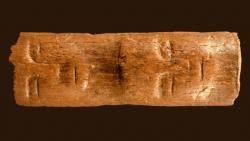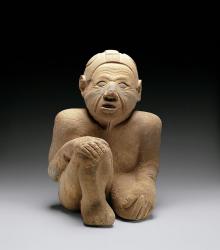INSTITUT SUPERIEUR D'ANTHROPOLOGIE
INSTITUTE OF ANTHROPOLOGY
ONLINE COURSES / COURS A DISTANCE
SPRING TERM : APRIL 2014
REGISTER NOW
SYRIE –  Tell Qarassa -A Neolithic era staff engraved with two realistic human faces has been discovered near a graveyard where some 30 people were buried without their heads. Archaeologists are now trying to determine what the ancient Syrians used it for. The bone wand was first uncovered during excavations in 2007 and 2009 at a site in southern Syria called Tell Qarassa. Strangely, the artifact and skeletons had previously been dug up and placed near an inhabited portion of the settlement. Juan José Ibáñez and his colleagues made the discovery before the civil war, but thankfully the area has escaped damage. The site dates back to the late ninth millennium BC. The bone wand, which was found in a funerary layer, was likely carved from the rib of an auroch. It depicts two carved human faces and was likely used in funeral rituals. According to the archaeologists, it may be a depiction of powerful supernatural beings — or it could represent a new way of perceiving human identity and facing the inevitability of death. These ancient people may have believed that, by representing the dead in visual form, the living and the dead could be brought closer together.
Tell Qarassa -A Neolithic era staff engraved with two realistic human faces has been discovered near a graveyard where some 30 people were buried without their heads. Archaeologists are now trying to determine what the ancient Syrians used it for. The bone wand was first uncovered during excavations in 2007 and 2009 at a site in southern Syria called Tell Qarassa. Strangely, the artifact and skeletons had previously been dug up and placed near an inhabited portion of the settlement. Juan José Ibáñez and his colleagues made the discovery before the civil war, but thankfully the area has escaped damage. The site dates back to the late ninth millennium BC. The bone wand, which was found in a funerary layer, was likely carved from the rib of an auroch. It depicts two carved human faces and was likely used in funeral rituals. According to the archaeologists, it may be a depiction of powerful supernatural beings — or it could represent a new way of perceiving human identity and facing the inevitability of death. These ancient people may have believed that, by representing the dead in visual form, the living and the dead could be brought closer together.
http://io9.com/a-9-000-year-old-ritual-wand-has-been-discovered-in-s-1542116752?
USA –  Tennessee - “Sandy,” a prehistoric Native American sandstone statue of a kneeling male figure found in Wilson County, is set to become the official artifact of Tennessee.“Tennessee’s archaeological heritage stretches back to the end of the last ice age and includes around 30,000 recorded sites,” Peres said. “Naming Sandy as an official Tennessee symbol acknowledges the state’s ancient past and will encourage Tennesseans to learn more about and work to help preserve our shared history. Listing Sandy as the state artifact also honors the legacy and accomplishments of Native Americans who lived in Tennessee for more than 10,000 years prior to the arrival of European settlers.”Sandy is part of the permanent collections at the McClung Museum of Natural History and Culture at the University of Tennessee in Knoxville.Sandy was found in 1939 with a companion female statue at a farm in Wilson County at the Sellars archaeological site. The 18-inch statue was carved between 1000 and 1350 A.D. and is from the Mississippian Period.::Sandy depicts an older male with wrinkles under his eyes and a sagging neck. Black pigment was also used to highlight his eyes and to create a broad line from cheek to cheek across the nose. Sandy’s head is covered with an elaborate hairstyle and long braid going down his back, which may symbolize his elite status and/or have a ritual purpose.
Tennessee - “Sandy,” a prehistoric Native American sandstone statue of a kneeling male figure found in Wilson County, is set to become the official artifact of Tennessee.“Tennessee’s archaeological heritage stretches back to the end of the last ice age and includes around 30,000 recorded sites,” Peres said. “Naming Sandy as an official Tennessee symbol acknowledges the state’s ancient past and will encourage Tennesseans to learn more about and work to help preserve our shared history. Listing Sandy as the state artifact also honors the legacy and accomplishments of Native Americans who lived in Tennessee for more than 10,000 years prior to the arrival of European settlers.”Sandy is part of the permanent collections at the McClung Museum of Natural History and Culture at the University of Tennessee in Knoxville.Sandy was found in 1939 with a companion female statue at a farm in Wilson County at the Sellars archaeological site. The 18-inch statue was carved between 1000 and 1350 A.D. and is from the Mississippian Period.::Sandy depicts an older male with wrinkles under his eyes and a sagging neck. Black pigment was also used to highlight his eyes and to create a broad line from cheek to cheek across the nose. Sandy’s head is covered with an elaborate hairstyle and long braid going down his back, which may symbolize his elite status and/or have a ritual purpose.
http://www.lebanondemocrat.com/article/state-government/352376
MYANMAR –  Linzin - Sixteen ancient Buddha images from the early Konbaung dynasty era have been excavated at the old Armenian cemetery site inside the Linzin cemetery in Amarapura of Mandalay Region.The images were found on March 5 and 6 while clearing the surroundings of the Tawagu Pagoda on the site of the old cemetery. A statue of a Nat (spirit) was also found together with the Buddha images. According to Myanmar traditional architect Win Maung (Tampawaddy), the cemetery site was once known as Hteepaung Ayat during the early Kongbaung dynasty era, which was inhabited by Innwa residents. "The ancient Buddha images were found while clearing the surroundings of the Tawagu Pagoda at the site of the old Armenian cemetery," said Win Maung (Tampawaddy), a Myanmar traditional architect. "The handiworks of the Buddha images are from early Konbaung dynasty era. It's before the Amarapura era." "Sixteen Buddha images have been found now. As these images have been enshrined inside a pagoda, there should be a total of 28 images. The Thidagu Sayadaw has instructed us to maintain the area where they were found as there are historical religious buildings," said Win Maung (Tampawaddy).
Linzin - Sixteen ancient Buddha images from the early Konbaung dynasty era have been excavated at the old Armenian cemetery site inside the Linzin cemetery in Amarapura of Mandalay Region.The images were found on March 5 and 6 while clearing the surroundings of the Tawagu Pagoda on the site of the old cemetery. A statue of a Nat (spirit) was also found together with the Buddha images. According to Myanmar traditional architect Win Maung (Tampawaddy), the cemetery site was once known as Hteepaung Ayat during the early Kongbaung dynasty era, which was inhabited by Innwa residents. "The ancient Buddha images were found while clearing the surroundings of the Tawagu Pagoda at the site of the old Armenian cemetery," said Win Maung (Tampawaddy), a Myanmar traditional architect. "The handiworks of the Buddha images are from early Konbaung dynasty era. It's before the Amarapura era." "Sixteen Buddha images have been found now. As these images have been enshrined inside a pagoda, there should be a total of 28 images. The Thidagu Sayadaw has instructed us to maintain the area where they were found as there are historical religious buildings," said Win Maung (Tampawaddy).
http://www.elevenmyanmar.com/index.php?option=com_content&view=article&id=5315:ancient-buddha-images-found-in-linzin-cemetery&catid=44:national&Itemid=384